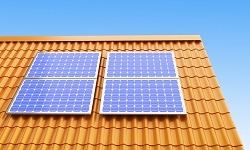
In a world where renewable energy is becoming commonplace, more people are thinking about implementing solar panels in both business and home spaces. Most frequently, solar panels are installed on the roof, but this can be a tricky process because roofs are not typically set up for solar panel usage. To get the best use out of solar panels, here are five questions to consider when installing solar panels:
- What's the best angle?
The angle at which a roof sits can actually impact the effectiveness of the solar panels. To optimize the amount of energy a solar panel can generate, the pitch of the roof should be 30 degrees. Furthermore, a roof steeper than 30 degrees makes installation both difficult and dangerous.
- Is it the right direction?
The orientation refers to the direction the roof faces. This is even more important than pitch in determining how much sun a solar panel can absorb. In North America, there are two schools of thought when placing solar panels: South-facing and West-facing. South-facing panels will generate the most energy, however, West-facing panels will produce more energy in the evening when demand is high. Even East-facing panels are an option, although, there can be up to a 20% decrease in potential energy generated. Ultimately, the choice is up to the user. South-facing panels will optimize usage, but in the end solar panels must be installed based upon the existing structure of a building.
- Does size matter?
In addition to orientation, the size of a roof will determine where solar panels can be installed. For each panel, there needs to be at least 15 square feet of roof. On average, a home might need 20 panels, which means there needs to be 300 square feet of space in order to install effective solar panels. This is also a factor to consider when choosing the orientation because even though South-facing is ideal, not every roof will have enough space.
- Which roofing material works best?
Surprisingly, solar panels can be installed on most types of roofing material. In the United States, asphalt shingles are the most common, and make for an easy installation process. Other materials such as slate, wood, and metal are also compatible with solar panel installation, but some materials make the process more difficult. If that's the case, then expect a higher installation cost.
- Is it time to retire your roof?
Finally, the age of a roof is extremely important when installing solar panels. Some roofing materials are more long-lasting than others. For example, asphalt shingles need to be replaced every 20 years, while other materials can last up to 50 years. Before installing solar panels, consider when your roof may need to be replaced. If it's within the next 10 years, it would be best to replace the roof before installing the solar panels because most panels can last 20 years or more.
If it’s time to replace your roof, it’s best to use durable materials that will last as long as your new solar panels. SCRAIL® RoofLoc® fasteners, offered by BECK America, make installation faster, increase durability, and the new nose design allows for better placement in tight areas. To learn more about our SCRAIL® RoofLoc® system, watch the video: SCRAIL® RoofLoc® - Because Quality Matters-to-action.
.svg.png)

